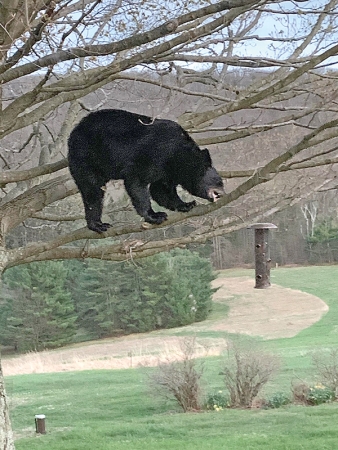I don’t know about you, but I am really, really ready for spring to arrive. Daytime temperatures seem to be running 10-12 degrees below normal almost every day, and yes, there were those couple of days that hit temperatures in the 70s, but generally it sure doesn’t seem like spring is upon us. There are, however, some usual harbingers of spring like the robins, numerous varieties of waterfowl that stop over briefly on their way north, and the emergence of the bright and flashy goldfinches.
While I have lived in my current home on a secluded hilltop for over 20 years, I rarely have ever seen a cardinal outside my window. No more than two or three times over these last two decades have I caught a fleeting glance of a male cardinal as it stopped briefly on its way to a further destination. This year, for the first time, a mating pair of cardinals seemed to be settling in to nest nearby. I had seen both the male and female several times and often would be greeted by their unique song at daybreak. With the cardinals in mind, I decided to break tradition.
It was the afternoon of Thursday, April 16, that I — for the first time ever — decided to hang a bird feeder. I did so with the hopes of keeping the cardinals nearby and looked forward to seeing whatever other songbirds might appear. I filled it to the top with black oil sunflower seeds since they are a favorite of the cardinal, and I hung it on a limb of a large maple tree that was just outside the back door. It was a great spot since it was plainly visible from the kitchen sink, through the glass of the back door and from the southern facing windows of the family room.
It was on the third day that the feeder was first noticed by a nuthatch, which was quickly joined by several white crowned sparrows. Every day thereafter, a new species of songbirds would show up. There were the blue jays, slate colored juncos, tufted titmouse, and then the goldfinches began to gather. At times there were 25-30 goldfinches on the ground, on the feeder and perched in the tree. What a sight! Over the next couple of weeks, the feeder was visited by a male rose breasted grosbeak, a rufous-sided towhee, chickadees, and, much to my enjoyment, both the male and female cardinals frequented the feeder as well. But all of that was about to change.
On Monday, May 4, the feeder had been providing entertainment for 18 days. It was interesting to note the variety of birds using it and, at times, the large numbers of goldfinches that swarmed around it. And then it happened.
It was 8:20 p.m. and the sun had settled in the western sky. I had just sat down to watch a little television and enjoy a hot-out-of-the-oven slice of pizza when a very bazaar picture appeared before me. I was stunned! I was speechless! There, framed in the glass panes of the back door was a 150-pound black bear, standing and perfectly balanced on the limb of the maple tree from which the feeder was hanging! It was just 12 feet beyond the back door!
I slipped to the glass door of the family room for a closer look, only to see him take a bite out of the limb in hopes that he could bite through it and make the feeder fall to the ground. I slowly opened the door without drawing his attention, and then yelled and waved my arms. He raised his head and looked at me — not impressed at all! After firing 4 rounds in the air from a 9mm handgun, he turned, slid down the tree and ran off!
Needless to say, I immediately took the feeder down! I had contemplated hanging it during the daytime, when I am home or nearby, but unfortunately, it would be foolhardy to provoke another visit by a bear. Yes, the Pennsylvania Game Commission warns well-meaning folks every spring against using bird feeders in order to watch the visiting songbirds. And they are totally correct in warning against such activity. Black bears have an extremely keen sense of smell, and will come from long distances to investigate such an attraction. Once they come to the smell of the black oil sunflower seeds, they may just get into other mischief as well.
It was a lesson learned the hard way. I hope you will learn from my mistake.





Leave a Comment
Your email address will not be published. Required fields are marked with *